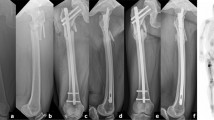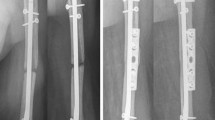Abstract
Purpose
In recent years, plate augmentation over a retained intramedullary (IM) nail has been shown to be an effective option for managing femur fracture nonunions because it improves the biomechanical environment of the fracture site without causing additional biological damage. In the current study, we present outcome data from 22 consecutive patients treated with plate augmentation for femoral shaft nonunion leaving the nail in situ.
Patients and methods
Between 2015 and 2018, 22 consecutive patients with femoral shaft aseptic nonunion after IM nailing were treated with plate augmentation over a retained nail at four different institutions. Nonunion was categorized based on its anatomical location and was classified according to the Weber and Cech classification. Cortical defects greater than 1.0 cm, the type of nailing procedure, and the number of previous interventions were recorded. Patients were assessed clinically and radiographically to measure the healing of nonunion sites. The time to fracture union and complications were recorded. Descriptive statistics were used when applicable.
Results
One site location was supra-isthmic, 12 were isthmic, and 9 were infra-isthmic. There were 10 cases of vascular nonunion and 12 cases of avascular nonunion. A cortical defect greater than 1.0 cm was observed in three patients. Antegrade nailing was performed in 11 patients, and retrograde nailing was performed in 11 patients. Reaming was performed in 12 patients. In eight patients, the fracture was openly reduced during the IM nailing index procedure. The average number of previous interventions before augmentation plating was 1.6 (1–4). Bone union was achieved in 19 patients after augmentation plating with an average follow-up of 23.5 months (12–51 months). Excellent and good clinical results were observed in all patients. There was no plate or screw breakage, and no patient developed infection.
Conclusion
Augmentation plating leaving the nail in situ is an excellent option for treating femoral shaft nonunion after IM nailing, with a high union rate and few complications. We believe the technique should gradually replace exchange nailing as the standard of care for the majority of femoral shaft nonunions that occur after IM nailing.

Similar content being viewed by others
References
Rupp M, Biehl C, Budak M, Thormann U, Heiss C, Alt V. Diaphyseal long bone nonunions—types, aetiology, economics, and treatment recommendations. Int Orthop. 2018;42(2):247–58.
Park J, Kim SG, Yoon HK, Yang KH. The treatment of nonisthmal femoral shaft nonunions with IM nail exchange versus augmentation plating. J Orthop Trauma. 2010;24(2):89–94.
Medlock G, Stevenson IM, Johnstone AJ. Uniting the un-united: should established non-unions of femoral shaft fractures initially treated with IM nails be treated by plate augmentation instead of exchange IM nailing? A systematic review. Strateg Trauma Limb Reconstr. 2018;13(3):119–28.
Birjandinejad A, Ebrahimzadeh MH, Ahmadzadeh-Chabock H. Augmentation plate fixation for the treatment of femoral and tibial nonunion after intramedullary nailing. Orthopedics. 2009;32:409.
Chiang JC, Johnson JE, Tarkin IS, Siska PA, Farrell DJ, Mormino MA. Plate augmentation for femoral nonunion: more than just a salvage tool? Arch Orthop Trauma Surg. 2016;136(2):149–56.
Garnavos C. Treatment of aseptic non-union after intramedullary nailing without removal of the nail. Injury. 2017;48(Suppl 1):S76–S81.
Jhunjhunwala HR, Dhawale AA. Is augmentation plating an effective treatment for non-union of femoral shaft fractures with nail in situ? Eur J Trauma Emerg Surg. 2016;42(3):339–43.
Metsemakers WJ, Morgenstern M, McNally MA, Moriarty TF, McFadyen I, Scarborough M, Athanasou NA, Ochsner PE, Kuehl R, Raschke M, Borens O, Xie Z, Velkes S, Hungerer S, Kates SL, Zalavras C, Giannoudis PV, Richards RG, Verhofstad MHJ. Fracture-related infections: a consensus on definition from an International Expert Group. Injury. 2018;49(3):505–10.
Vaishya R, Agarwal AK, Gupta N, Vijay V. Plate augmentation with retention of intramedullary nail is effective for resistant femoral shaft non-union. J Orthop. 2016;13(4):242–5.
Fontenot PB, Diaz M, Stoops K, Barrick B, Santoni B, Mir H. Supplementation of lateral locked plating for distal femur fractures: a biomechanical study. J Orthop Trauma. 2019;33(12):642–8.
Wu CC. Treatment of femoral shaft aseptic nonunion associated with plating failure: emphasis on the situation of screw breakage. J Trauma. 2001;51(4):710–3.
Rodrigues CFS, Lima FJC, Barbosa FT. Importance of using basic statistics adequately in clinical research. Rev Bras Anestesiol. 2017;67(6):619–25.
Hussain N, Hussain FN, Sermer C, Kamdar H, Schemitsch EH, Sternheim A, Kuzyk P. Antegrade versus retrograde nailing techniques and trochanteric versus piriformis intramedullary nailing entry points for femoral shaft fractures: a systematic review and meta-analysis. Can J Surg. 2017;60(1):19–29.
Kim JW, Oh CW, Oh JK, Park KH, Kim HJ, Kim TS, Park EK. Treatment of infra-isthmal femoral fracture with an intramedullary nail: is retrograde nailing a better option than antegrade nailing? Arch Orthop Trauma Surg. 2018;138(9):1241–7.
Author information
Authors and Affiliations
Corresponding author
Ethics declarations
Conflict of interest
The authors declare that they have no conflict of interest.
Ethical standards
Ethical clearance has been taken from the institutional ethical committee.
Rights and permissions
About this article
Cite this article
Uliana, C.S., Bidolegui, F., Kojima, K. et al. Augmentation plating leaving the nail in situ is an excellent option for treating femoral shaft nonunion after IM nailing: a multicentre study. Eur J Trauma Emerg Surg 47, 1895–1901 (2021). https://doi.org/10.1007/s00068-020-01333-0
Received:
Accepted:
Published:
Issue Date:
DOI: https://doi.org/10.1007/s00068-020-01333-0




